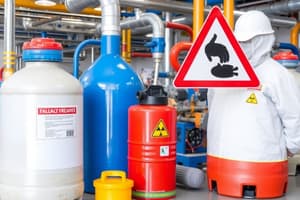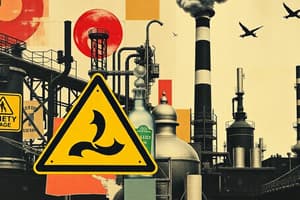Podcast
Questions and Answers
What is the primary focus of job safety analysis?
What is the primary focus of job safety analysis?
- Training employees on safety protocols
- Evaluating equipment performance
- Conducting environmental impact assessments
- Identifying potential hazards in job tasks (correct)
Which technique is NOT a method for hazard identification?
Which technique is NOT a method for hazard identification?
- Cost-benefit analysis (correct)
- Inductive hazard analysis
- Deductive hazard analysis
- Fault tree analysis
The Permit to Work system is mainly intended to ensure:
The Permit to Work system is mainly intended to ensure:
- Efficiency in job scheduling
- Control over hazardous work activities (correct)
- Reduction of operating costs
- Compliance with legal regulations
What is the primary objective of safety sampling?
What is the primary objective of safety sampling?
Which of the following is an example of an onsite emergency planning technique?
Which of the following is an example of an onsite emergency planning technique?
Flashcards
Hazard Identification
Hazard Identification
The process of identifying potential dangers that could cause harm to people, property, or the environment. This is the first step in risk management.
Risk Assessment
Risk Assessment
Evaluating the likelihood and severity of identified hazards. It helps determine the significance of each risk and prioritize actions.
Accident Investigation
Accident Investigation
A systematic process of examining an accident to understand its root causes, contributing factors, and potential prevention measures.
Emergency Preparedness
Emergency Preparedness
Signup and view all the flashcards
Major Accident Hazard Control
Major Accident Hazard Control
Signup and view all the flashcards
Study Notes
Plant and Equipment Safety
- Plant safety appraisal and control techniques aim to prevent accidents and improve workplace safety.
- Techniques include observations, inspections, sampling, surveys, job safety analysis, inventory systems, and product safety programs.
- Permit-to-work and safety tag systems are used to manage hazardous tasks and equipment.
- Loss control, damage control, and system safety are integral components of the process.
Laws and Regulations
- Key regulatory frameworks governing hazardous materials include the Manufacture, Storage, and Import of Hazardous Chemicals (Amendment) Rules of 2000.
- Other relevant regulations include the Chemical Accidents (Emergency Preparedness, Planning, and Response) Rules of 1986 and the Hazardous Waste (Management, Handling, and Transboundary Movement) Rules of 2008.
Hazards and Risks
- Hazard identification strategies are crucial, utilizing inductive, deductive, FMEA (Failure Mode and Effects Analysis), and CMA (Cause Mapping Analysis) techniques.
- Fault tree analysis helps to understand how hazardous events can occur through systematic breakdown of potential failures.
- Evaluating and assessing risk is vital for appropriate responses.
- Accurate accident investigation, reporting, and analysis are necessary for performance measurement and control.
- Hazard analysis techniques and their suitable measurement tools are integral to a comprehensive approach.
Major Accident Hazard Control
- Understanding major accident hazards, their evaluation, and associated consequences are important.
- Management, local authorities, and the public all have roles in managing these hazards.
- Efficient onsite and offsite emergency planning, including case studies, are vital for effective risk management.
- Implementation of control procedures and systems is critical for major accident hazard prevention and mitigation.
Importance of Disaster Management
- Disaster management involves emergency preparedness at both local and global levels.
- Contingency plans and emergency preparedness align with standards like ISO 14001, OHSA's 18001, and OSHA's Process Safety Management System.
Studying That Suits You
Use AI to generate personalized quizzes and flashcards to suit your learning preferences.
Description
Test your knowledge on plant and equipment safety measures, focusing on safety appraisal, regulatory frameworks, and hazard identification strategies. This quiz covers important laws and techniques to prevent accidents and ensure workplace safety. Assess your understanding of the crucial safety systems and regulations in the hazardous materials domain.




